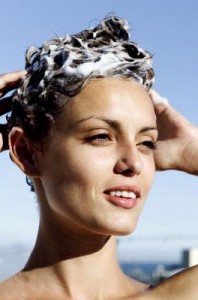Shampoo Information Dallas
Hair Shampoo
Shampoos have made major advances since they were originally introduced. Besides simply cleaning the hair, they can also repair and protect hair as well as provide luster and shine with certain additives.
Soap Shampoo
This is the original hair cleanser. This alkali-based product also contains oils and salts of fatty acids. Soap shampoos are effective cleansers and are inexpensive. However, they form a scum layer on hair when hard water is used (which accounts for the majority of water out there) so soap shampoos are relatively infrequently used today.
Detergent Shampoo
In the 1950s, detergent shampoos were developed since most people live with hard water. They are composed of principal surfactants for detergency and foaming power, secondary surfactants to condition the hair, and additives. The detergent shampoo works by transferring dirt with a lipophilic component to the rinse water with a hydrophilic component.
Anionic Surfactants
Anionic surfactants are the principal detergents used in detergent shampoos. Sodium lauryl sulfates and ammonium lauryl sulfates are very strong and alkaline cleansers but may be too irritative in individuals with chemically damaged hair. Disodium ricinoleamide MEA-sulfosuccinate may be a suitable alternative to these harsher agents but generally leave the hair in poor condition and are associated with a higher incidence of allergic contact dermatitis. Triethanoloamine (TEA) salts of alkyl sulfates are more easily tolerated and can be mixed with stronger detergents. Sarcosines clean poorly but leave the hair in better condition. Laureth sulfates are less irritating than lauryl sulfates but do not clean as vigorously.
Nonionic Surfactants
In general, nonionic surfactants act as secondary surfactants by increasing the quality of the lather, viscosity, and solubility. Examples are ethoxylated fatty alcohols, ethoxylated alkyl phenols, ethoxylated fatty amines, ethoxylated fatty amides, sorbitol esters, polyglycerol ether and amine oxide.
Amphoteric Surfactants
Amphoteric surfactants contain a balance of both positive and negative charges. They are very gentle cleansers and are the major components of baby shampoos. They are gentle in their cleansing and do not irritate the eyes. Examples include N-alkyl-amino acids, betaines, and alkyl imidazoline compounds.
Additives
Additives are used to provide other benefits other than cleansing. Beautifiers like hydrolyzed animal proteins are used to repair split ends by electrostatic attachment to the damaged hair. Thickeners like sodium chloride are used to give more viscosity to the shampoo product. Sequestering agents like polyphosphates and ethylenediamineetetraacetic acid keep calcium, iron, and magnesium salts from precipitating on the hair shaft. Preservatives like formaldehyde are used to prevent bacterial contamination to a water-based product like shampoo. Aesthetic additives help achieve the desired color and fragrance to improve marketability of the product. Tar, selenium sulfide, zinc pyrithione, salicylic acid, sulfur, and ketoconazole are therapeutic additives to treat conditions like psoriasis, seborrheic dermatitis, and dandruff.
Shampoos for Different Hair Types
A shampoo formulated for oily hair has a higher percentage of anionic surfactants, and a shampoo for dry hair would have a weaker anionic component. Limp or fine hair must be treated with shampoo that has fewer conditioners that can weigh down the hair but instead have more protein additives that can provide extra body. Permed or damaged hair must have a higher percentage of amphoteric surfactants or non-ionic surfactants to preserve the more vulnerable cuticle.




